Communities
Communities in biological sciences refer to groups of interacting species living in the same area. These interactions can include competition, predation, and mutualism, and they play a crucial role in shaping the structure and function of ecosystems. Understanding the dynamics of communities is essential for studying biodiversity, ecological processes, and conservation efforts.
6 Key excerpts on "Communities"
- eBook - ePub
Dynamic Aquaria
Building Living Ecosystems
- Walter H. Adey, Karen Loveland(Authors)
- 2011(Publication Date)
- Academic Press(Publisher)
...Later we return to the numbers issue: Why do some Communities have far more species than others? THE COMMUNITY Community structure is the ecologist’s term for indicating what organisms are present in a given environment, in what numbers, and how they relate to each other. Another way to look at a community is as a collection of niches or slots that organisms can fit into in order to “make a living.” In Chapter 13 on ecosystems and trophic structure, or food chains, we discuss rates of production, of feeding, and of energy and material flow. There is no sharp line between the subject matter of these two chapters. This chapter refers more to static and behavioral aspects, and Chapter 13 to dynamic aspects. The term community is rather arbitrary. Its boundaries can be as wide or as narrow as one chooses to make them. For example, a rocky-shore community could refer to a thousand miles of coastline or to a kelp community in a band tens to hundreds of feet wide on that coast, or the kelp epiphyte community could refer to those organisms growing on single kelp plants. Reasonably sharp community boundaries are required for such a designation, but even that criterion is sometimes rather fuzzy. Traditionally, a biological community is named for a dominant element or elements. An Acropora palmata reef community is conspicuously dominated by that single coral species as a major element of biomass or structure, controlling many other organisms by its presence. A Batis–Distichlis salt marsh community is a salt marsh in which the saltwort Batis and the salt grass Distichlis more or less equally provide the primary vegetation and therefore cover in the marsh. THE BIOME Biomes are the largest-scale terrestrial Communities (Figure 12.2). They are defined primarily by the effect climate (temperature and precipitation) has on the dominant community structure-creating plants...
- eBook - ePub
Fundamentals of Ecotoxicology
The Science of Pollution, Fifth Edition
- Michael C. Newman(Author)
- 2019(Publication Date)
- CRC Press(Publisher)
...CHAPTER 11 Effects to Communities and Ecosystems The accumulation of persistent toxic substances in the ecological cycles of the earth is a problem to which mankind will have to pay increasing attention … What has been learned about the dangers in polluting ecological cycles is ample proof that there is no longer safety in the vastness of the earth. Woodwell (1967) 11.1 Overview 11.1.1 Fundamental Definitions and Qualifications An ecological community is “an assemblage of [species] populations living in a prescribed area or physical habitat: it is an organized unit to the extent that it has characteristics additional to its individual and population components … [it is] the living part of the ecosystem” (Odum, 1971). A community—perhaps of a lake or meadow—is made up of interacting species that form an integrated unit. Some species in a community interact only loosely while others engage in strong interactions that are crucial for maintaining community structure and function (Magurran, 1988). Species fit into an ecological community in different ways. These differences are conventionally framed in the context of the Hutchinsonian niche, that being, “the certain biological activity space in which an organism exists in a particular habitat. This space is influenced by the physiological and behavioral limits of a species and by effects of environmental parameters (physical and biotic, such as temperature and predation) acting on it” (Wetzel, 1982). A species in a particular area will have a fundamental niche in which it could exist based on its physiological and other limitations. It will also have a realized niche which is that portion of its fundamental niche that it actually occupies. The realized niche is often smaller than the fundamental niche due to the inhibitory influences of other species such as predators and competitors...
- eBook - ePub
Foundations of Ecology
Classic Papers with Commentaries
- Leslie A. Real, James H. Brown, Leslie A. Real, James H. Brown(Authors)
- 2012(Publication Date)
- University of Chicago Press(Publisher)
...LINDEMAN Osborn Zoological Laboratory, Yale University Recent progress in the study of aquatic food-cycle relationships invites a reappraisal of certain ecological tenets. Quantitative productivity data provide a basis for enunciating certain trophic principles, which, when applied to a series of successional stages, shed new light on the dynamics of ecological succession. “COMMUNITY” CONCEPTS A chronological review of the major viewpoints guiding synecological thought indicates the following stages: (1) the static species-distributional viewpoint; (2) the dynamic species-distributional viewpoint, with emphasis on successional phenomena; and (3) the trophic-dynamic viewpoint. From either species-distributional viewpoint, a lake, for example, might be considered by a botanist as containing several distinct plant aggregations, such as marginal emergent, floating-leafed, submerged, benthic, or phytoplankton Communities, some of which might even be considered as “climax” (cf. Tutin, ’41). The associated animals would be “biotic factors” of the plant environment, tending to limit or modify the development of the aquatic plant Communities. To a strict zoologist, on the other hand, a lake would seem to contain animal Communities roughly coincident with the plant Communities, although the “associated vegetation” would be considered merely as a part of the environment 1 of the animal community. A more “bio-ecological” species-distributional approach would recognize both the plants and animals as co-constituents of restricted “biotic” Communities, such as “plankton Communities,” “benthic Communities,” etc., in which members of the living community “co-act” with each other and “react” with the non-living environment (Clements and Shelford, ’39; Carpenter, ’39, ’40; T. Park, ’41)...
- eBook - ePub
Biology
A Self-Teaching Guide
- Steven D. Garber(Author)
- 2020(Publication Date)
- Jossey-Bass(Publisher)
...15 Ecology Ecology is a theoretical, quantitative study of organisms, populations, species, Communities, and ecosystems. Both locally and globally, this highly integrative discipline incorporates information, processes, techniques, and data for related fields represented in the previous chapters, as well as inorganic chemistry, organic chemistry, physics, meteorology, geology, soil science, evolution, genetics, immunology, pathology, bioengineering, behavior, and natural history. While all disciplines are interdisciplinary to some extent, few are as interdisciplinary as ecology. The study of the interactions of organisms, with each other and with the environment, is far more complex than we can fully comprehend. However, that doesn't stop us from trying. Ecology began as a pure science, primarily the study of species in their natural habitats, and expanded into a science involved with ecological principles and mechanisms. Much of the theoretical aspect of this field has yet to be used in any practical way. Ecological studies provide a valuable base for all those who plan to enter a field that will potentially affect the environment. It would be much better if far more people studied ecology at some time in their life. Unfortunately, too many children grow up thinking ecology is all about recycling, period. Ecology is far more than just that, and for legislators to ensure that we don't destroy much that lives on our planet, it's important for them to learn that healthy people and healthy Communities need far more than a robust economy. We also need to make sure that everyone has access to a healthy, beautiful, vibrant, natural environment. And for species to survive, we cannot just save a small number of parks where everyone goes on vacation. We need places where plants and animals, and fungi and bacteria can live on in perpetuity, without becoming threatened or endangered...
- eBook - ePub
Applied Population and Community Ecology
The Case of Feral Pigs in Australia
- Jim Hone(Author)
- 2012(Publication Date)
- Wiley-Blackwell(Publisher)
...Chapter 2 Applied Population and Community Ecology The topics of population and community ecology are broad. In this chapter, selected aspects of the application of topics in ecology are examined briefly in sequence. Empirical aspects of the same topics are then examined in Chapters 4–8. Distribution The distribution of a species can range from continuous—occurring everywhere—to patchy. In a patchy distribution the patches can range from being independent, such as in a set of relic populations, to non-independent because of movement of individuals between patches. The latter is a metapopulation, such as has been reported in some butterfly species (Hanski 1999). Invasion The central concept of invasions is that a species spreads from one location and community to another. The topic has a long history of empirical and theoretical development (Elton 1958; Drake & Mooney 1989; Davis 2009). Invasion is often divided into three phases or stages (Shea & Chesson 2002). The first stage is introduction, which is related to movements and scales. The second stage is establishment, which occurs when the net reproductive rate (R) is greater than 1.0 and is essentially population ecology. It is a function of the niche and niche opportunity (Shea & Chesson 2002). Community interactions are important because an invader needs to have lower resource requirements than its competitor(s) (Tilman 1982). The third stage of invasion is spread, which is again related to movements and scale. Dispersion Dispersion is the spatial pattern of individuals in a population. Individuals are often clumped (or ‘aggregated’) (Taylor 1961) in many animal and plant populations (Anderson et al. 1982). Rarely are individuals randomly or regularly dispersed within a population (Taylor 1961). Population Density Population density is defined as the number of individuals per unit area. Density can be estimated using a range of methods (Seber 1982; Krebs 1999; Lancia et al...
- eBook - ePub
- Charles Krebs(Author)
- 2008(Publication Date)
- CSIRO PUBLISHING(Publisher)
...Biodiversity does not appear to have any fixed upper limit in natural Communities. SUMMARY Biodiversity can be measured at the genetic level, at the species level or at the ecosystem level. Most often species are the focus of study, and by counting all the species in an area we measure species richness as an index of biodiversity. Communities vary greatly in the numbers of species they contain, and this chapter describes the patterns of biodiversity over the globe and then relates these patterns to ecological mechanisms that can affect biodiversity. Figure 12.19 Local and regional biodiversity plot. If local Communities are unsaturated, the diversity of Communities will go on increasing with regional diversity in a linear manner (blue line). Richer regions will have richer local Communities. On the other hand, if local Communities are saturated with species they will reach an asymptote or maximum species richness (red line) set by competition for resources and niche overlap. To test for saturation several Communities in several different regions are needed. Many species remain to be described, and only some groups, such as birds, mammals and butterflies, are named and well described. Insects comprise more than half of the total biodiversity of the Earth’s 15–30 million species. These species are not evenly spread over the Earth. Hotspots of biodiversity are regions with large numbers of rare species, and they occur largely in tropical areas and in a few temperate regions, such as California. Hotspots contain nearly 50% of all species on only about 1–2% of the Earth’s land surface. Figure 12.20 Local and regional species richness across continents for nine different taxonomic groups. There is no indication of saturation in this relationship and remarkably all the different groups on different continents appear to follow the same linear regression...





